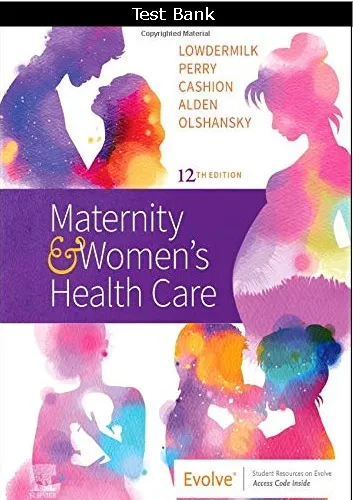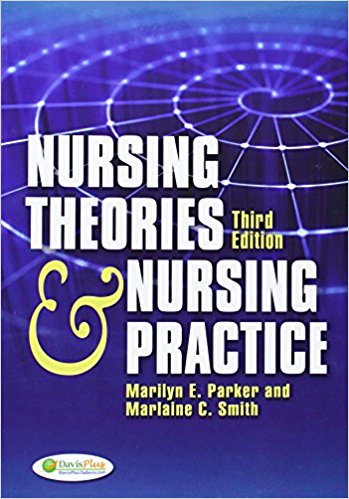Maternity and Women’s Health Care 12th edition Test Bank
$55.00 Original price was: $55.00.$13.50Current price is: $13.50.
Digital item No Waiting Time Instant Download
Chapters: 37
Format: PDF
ISBN-13: 978-0323556293
ISBN-10: 0323556299
Publisher: Mosby
Authors: Deitra Leonard Lowdermilk, Mary Catherine Cashion,
Shannon E. Perry, Kathryn Rhodes Alden, Ellen Olshansky
Description
Maternity and Women’s Health Care 12th edition Test Bank
Table of Contents
Unit Five: Postpartum
20. Postpartum Physiologic Changes
21. Nursing Care of the Family During the Postpartum Period
22. Transition to Parenthood
Unit Six: Newborn
23. Physiologic and Behavioral Adaptations of the Newborn
24. Nursing Care of the Newborn and Family
25. Newborn Nutrition and Feeding
Unit Seven: Complications of Pregnancy
26. High Risk Pregnancy Assessment
27. Hypertensive Disorders
28. Hemorrhagic Disorders in Pregnancy
29. Endocrine and Metabolic Disorders
30. Medical-Surgical Disorders
31. Mental Health Disorders and Substance Abuse
32. Labor and Birth Complications
33. Postpartum Complications
34. Nursing Care of the High Risk Newborn and Family
Unit Eight: Newborn Complications
35. Acquired Problems of the Newborn
36. Hemolytic Disorders and Congenital Anomalies
37. Perinatal Loss and Grief
Glossary
Maternity & Women’s Health Care 12th Edition Lowdermilk Test Bank
Chapter 1: 21st Century Maternity and Women’s Health Nursing
MULTIPLE CHOICE
1. In evaluating the level of a pregnant womans risk of having a low-birth-weight (LBW) infant,
which factor is the most important for the nurse to consider?
a. African-American race
b. Cigarette smoking
c. Poor nutritional status
d. Limited maternal education
ANS: A
For African-American births, the incidence of LBW infants is twice that of Caucasian births.
Race is a nonmodifiable risk factor. Cigarette smoking is an important factor in potential infant
mortality rates, but it is not the most important. Additionally, smoking is a modifiable risk factor.
Poor nutrition is an important factor in potential infant mortality rates, but it is not the most
important. Additionally, nutritional status is a modifiable risk factor. Maternal education is an
important factor in potential infant mortality rates, but it is not the most important. Additionally,
maternal education is a modifiable risk factor.
DIF: Cognitive Level: Understand REF: IM:
TOP: Nursing Process: Assessment
MSC: Client Needs: Health Promotion and Maintenance, Antepartum Care
2. What is the primary role of practicing nurses in the research process?
a. Designing research studies
b. Collecting data for other researchers
c. Identifying researchable problems
d. Seeking funding to support research studies
ANS: C
When problems are identified, research can be properly conducted. Research of health care
issues leads to evidence-based practice guidelines. Designing research studies is only one factor
of the research process. Data collection is another factor of research. Financial support is
necessary to conduct research, but it is not the primary role of the nurse in the research process.
DIF: Cognitive Level: Understand REF: im: 14 TOP: Nursing Process: N/A
MSC: Client Needs: Safe and Effective Care Environment
3. A 23-year-old African-American woman is pregnant with her first child. Based on the
statistics for infant mortality, which plan is most important for the nurse to implement?
a. Perform a nutrition assessment.
b. Refer the woman to a social worker.
c. Advise the woman to see an obstetrician, not a midwife.
d. Explain to the woman the importance of keeping her prenatal care appointments.
ANS: D
Consistent prenatal care is the best method of preventing or controlling risk factors associated
with infant mortality. Nutritional status is an important modifiable risk factor, but it is not the
most important action a nurse should take in this situation. The client may need assistance from a
social worker at some time during her pregnancy, but a referral to a social worker is not the most
important aspect the nurse should address at this time. If the woman has identifiable high-risk
problems, then her health care may need to be provided by a physician. However, it cannot be
assumed that all African-American women have high-risk issues. In addition, advising the
woman to see an obstetrician is not the most important aspect on which the nurse should focus at
this time, and it is not appropriate for a nurse to advise or manage the type of care a client is to
receive.
DIF: Cognitive Level: Understand REF: IM: TOP: Nursing Process: Planning
MSC: Client Needs: Health Promotion and Maintenance
4. During a prenatal intake interview, the nurse is in the process of obtaining an initial
assessment of a 21-year-old Hispanic client with limited English proficiency. Which action is the
most important for the nurse to perform?
a. Use maternity jargon to enable the client to become familiar with these terms.
b. Speak quickly and efficiently to expedite the visit.
c. Provide the client with handouts.
d. Assess whether the client understands the discussion.
ANS: D
Nurses contribute to health literacy by using simple, common words, avoiding jargon, and
evaluating whether the client understands the discussion. Speaking slowly and clearly and
focusing on what is important will increase understanding. Most client education materials are
written at a level too high for the average adult and may not be useful for a client with limited
English proficiency.
DIF: Cognitive Level: Apply REF: im: 5 TOP: Nursing Process: Evaluation
MSC: Client Needs: Health Promotion and Maintenance
5. The nurses working at a newly established birthing center have begun to compare their
performance in providing maternal-newborn care against clinical standards. This comparison
process is most commonly known as what?
a. Best practices network
b. Clinical benchmarking
c. Outcomes-oriented practice
d. Evidence-based practice
ANS: C





Be the first to review “Maternity and Women’s Health Care 12th edition Test Bank”